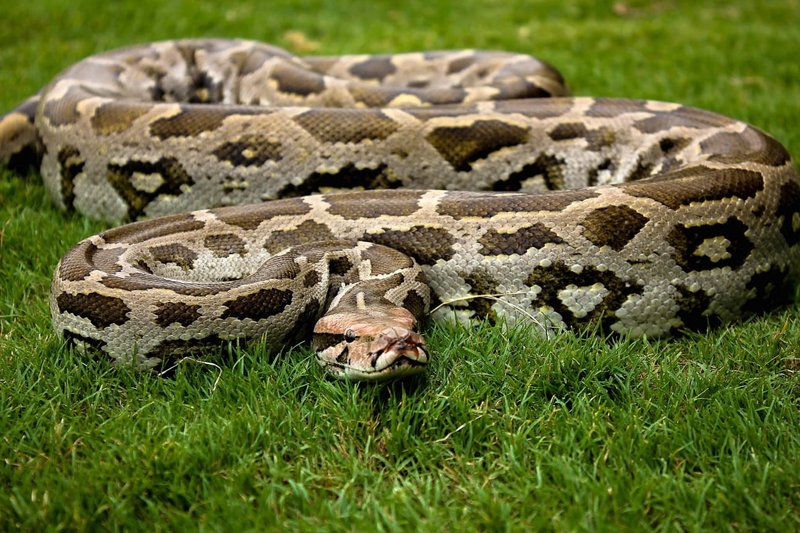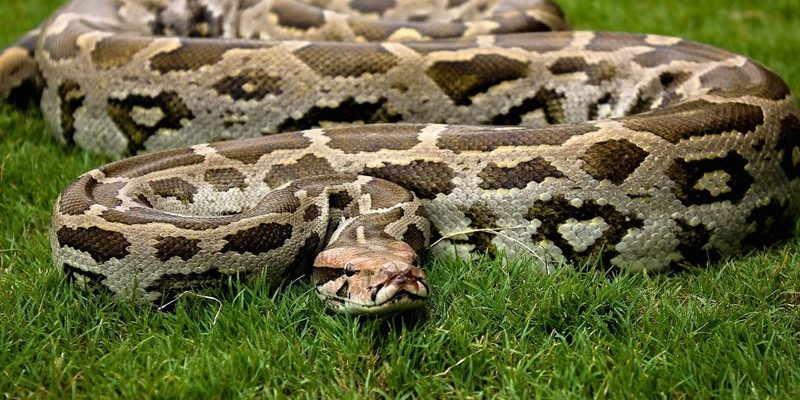
When you think of snakes, what comes to mind? Perhaps a slithering creature basking in the sun or curling around a branch? The Indian Rock Python is one of those captivating snakes that sparks curiosity and fascination. Known for its impressive size and striking patterns, this species is a true marvel of nature. Whether you’ve encountered one in the wild or just seen it in documentaries, the Indian Rock Python has a regal presence that can’t be ignored.
But what makes the Indian Rock Python so special? For starters, it’s not just its size. This snake plays a vital role in its ecosystem and possesses unique adaptations that let it thrive in a variety of environments. Think of it as a silent guardian of its habitat, expertly balancing the delicate web of life around it. In this article, we’ll explore the fascinating details of this remarkable creature, from its physical characteristics to its behavior and habitat.
Physical Characteristics
The Indian Rock Python can grow to impressive lengths, often reaching between 10 to 20 feet! Yes, you read that right! Imagine a snake longer than a small car! Its body is thick and muscular, covered in beautiful patterns that serve as both camouflage and decoration. These patterns usually include shades of brown, yellow, and black, giving them a striking appearance that’s both formidable and magnificent.
One key feature of the Indian Rock Python is its head shape. Unlike other snake species, this python has a broad head that is distinct from its neck. This not only helps it in hunting but also makes it easier for them to consume larger prey. Speaking of which, their jaws can stretch wide open, allowing them to swallow animals like deer and goats whole—now that’s quite a meal! You might find it fascinating how a snake’s jaw works; it’s not rigid like ours but has flexible ligaments that allow it to consume larger animals.
Habitat
So, where does this magnificent python call home? The Indian Rock Python boasts a diverse habitat preference, which includes tropical forests, grasslands, and even wetlands. These environments provide the perfect blend of hiding spots for ambushing prey and sunny spots for basking. You might find them lounging on a branch or coiled up near water sources.
Geographically, their range covers parts of India, Nepal, Bangladesh, and even Sri Lanka. Just imagine walking through a dense forest and possibly encountering one of these giants! Despite their size, they blend into their surroundings seamlessly, making them skilled predators. They often prefer to stay near water, which aids in their hunting strategy—after all, water is a hotspot for various types of prey.
Diet and Hunting Behavior
When it comes to food, the Indian Rock Python is known as a carnivore, with a diet primarily consisting of mammals and birds. They’re non-venomous and rely on constriction to subdue their prey. This means they wrap their powerful bodies around the victim, squeezing until it can no longer breathe. You might think it sounds brutal, but it’s a natural part of their survival.
The hunting technique employed by the Indian Rock Python is nothing short of masterful. They typically lie in wait, camouflaged by their surroundings. Their acute sense of smell, aided by their forked tongue, helps them detect prey from a distance. Once they spot a meal, they stealthily approach and strike with precision. It’s like watching a perfectly choreographed dance of nature.
Reproduction
The mating season for Indian Rock Pythons typically occurs during the warmer months. After a courtship display that can involve entwining their bodies, females lay anywhere from 20 to 100 eggs! Yes, that’s a lot of little snakes! The female python then protects her eggs by coiling around them, keeping them warm until they hatch. You can imagine the anticipation of those tiny hatchlings emerging into the world, ready to start their own lives.
Interestingly, the female can even control the temperature of her eggs by contracting her muscles, providing optimal conditions for development. This behavior shows just how dedicated she is to ensuring the survival of her offspring. Once the babies hatch, they are independent right away, showing no parental care, and must fend for themselves immediately. It’s a tough world out there!
Behavior and Social Structure
Indian Rock Pythons are generally solitary creatures, but they can sometimes be found cohabitating with others, especially in areas with ample resources. They are primarily nocturnal, which means they like to hunt and move around during the cooler night hours. This behavior helps them avoid the heat of the day and conserve energy.
What’s particularly interesting is their ability to adapt to various environments. Indian Rock Pythons can be quite arboreal, spending time in trees as well as on the ground, depending on their needs and available prey. They’re known to swim quite well, too! This versatility is one of the many reasons they thrive in different habitats.
Conservation Status
Unfortunately, like many wildlife species, the Indian Rock Python faces threats due to habitat loss, hunting, and the illegal pet trade. While they are currently classified as Least Concern on the IUCN Red List, ongoing conservation efforts are crucial to ensure they continue to thrive in their natural habitats. Protecting the ecosystems they inhabit is essential for their survival.
Many organizations work tirelessly to safeguard these magnificent creatures. Educating people about their ecological importance helps foster a sense of responsibility toward protecting them. As stewards of nature, it’s vital that we contribute to efforts aimed at preserving the Indian Rock Python and its habitat.
Fun Facts
- The Indian Rock Python can hold its breath for up to 30 minutes while submerged in water.
- They can consume prey up to twice their size!
- These pythons can live for over 25 years in captivity, but their lifespan in the wild is generally shorter due to various challenges.
- Their skin is often used for leather products, which has raised conservation concerns.
Interesting Comparisons
| Feature | Indian Rock Python |
| Length | 10-20 feet |
| Weight | Up to 90 pounds |
| Habitat | Tropical forests, wetlands, grasslands |
| Diet | Carnivorous (mammals and birds) |
| Lifespan | Up to 25 years in captivity |
The Indian Rock Python is a remarkable species that stands out for its impressive size and vital role in the ecosystem. From its unique hunting techniques to its beautiful patterns, there’s so much to admire about this giant snake. As humans, we share this planet with extraordinary creatures like the Indian Rock Python, and understanding them enables us to appreciate and protect the delicate balance of nature.
FAQ
What is the typical size of an Indian Rock Python?
The typical size of an Indian Rock Python ranges from 10 to 20 feet in length. However, there have been reports of individuals growing even larger! Their thick, muscular bodies add to their impressive presence, making them one of the largest snakes in the world.
Are Indian Rock Pythons dangerous?
While they are capable of inflicting serious harm, Indian Rock Pythons tend to avoid confrontations with humans. They are non-venomous and rely on constriction to catch prey. Generally, they pose little threat to humans unless provoked.
How do Indian Rock Pythons hunt?
Indian Rock Pythons hunt through a combination of camouflage and stealth. They stay motionless and blend into their surroundings, using their keen sense of smell to detect nearby prey. Once spotted, they strike quickly, wrapping around their victim to constrict it.
What do Indian Rock Pythons eat?
These pythons primarily eat small to medium-sized mammals and birds. Their diet can include animals like rodents, birds, and even larger mammals, depending on availability. They are known for their ability to consume prey larger than their own body diameter.
Where can you find Indian Rock Pythons in the wild?
Indian Rock Pythons primarily inhabit tropical forests, grasslands, and wetlands across regions of India, Nepal, Bangladesh, and Sri Lanka. They prefer areas where they can easily access water sources, which serve as prime hunting grounds.
How long do Indian Rock Pythons live?
In captivity, Indian Rock Pythons can live for over 25 years with proper care. In the wild, however, their lifespan tends to be shorter due to factors like predation, habitat loss, and hunting.
Are Indian Rock Pythons good pets?
While some people keep Indian Rock Pythons as pets, they require a significant commitment in terms of habitat, diet, and care. They can grow quite large and need plenty of space. If you’re considering one as a pet, ensure you have the necessary knowledge and resources.
Can Indian Rock Pythons swim?
Yes, Indian Rock Pythons are excellent swimmers! They often swim well when navigating through their habitats, allowing them to hunt for prey and escape threats. Their strong muscles and streamlined bodies aid in their swimming skills.
How do Indian Rock Pythons reproduce?
During mating season, female Indian Rock Pythons attract males through scent and physical displays. After mating, females lay eggs and incubate them by coiling around them. This protective behavior helps keep the eggs warm and increases the chances of survival for the hatchlings.
What is the conservation status of the Indian Rock Python?
The Indian Rock Python is classified as Least Concern on the IUCN Red List. However, they face threats from habitat loss and illegal hunting, making conservation efforts essential to their survival in the wild.

